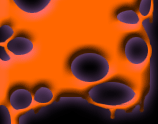Halloween is derived from the ancient Celtic festival of Samhain
(pronounced sow-in) from about 2000 years ago. November 1 was the day that they celebrated the new year. This holiday marked
the end of the summer season and the beginning of the cold and dark winter months, which the Celts equated with human death,
The night before this day was a day that they believed that the lines dividing the
living from the dead were blurred and the dead could walk the earth, like all saints day in Mexico. On October 31 the ghost
of the dead were allowed to wander the earth once again. These spirits would cause damage crops and play around causing trouble.
But their presence made it easier for the Celtic priest, druids, to make predictions for the future. These predictions were
comforting to the people and gave them some direction during the harsh and bitter winter.
For the celebration the druids would set up a huge bonfire and people would burn
animals and crops as sacrifices to the worshiped deities.
For this ceremony the Celts wore crude costumes made of things like animal head and
skins. After this they’d try to tell each others fortunes. After all the ceremony they’d re-light their hearths
with fire from the bonfire as a protection for the winter.
The Roman Empire had taken over most of the Celtic territory by A.D. 43. Within the
400 years they were under Roman rule, Samhain was merged with two Roman holidays. The first of the two Raman holidays was
Feralia, which took place in later October when they would traditionally recognize the passage of the dead. The second day
was to celebrate the goddess of fruits and trees, Pomona. The symbol for Pomona may have given rise to bobbing for apples,
since the symbol was the apple.
About 800 AD was when Christianity took a hand and took over the Celtic land. Pope
Boniface IV, in the 800’s decreed that November 1 was to be All Saints’ Day. This was a day to honor the saints
and martyrs tat they held In high esteem. Years later people started to think that the pope just wanted to replace the Celtic
holiday with a holiday, that is okayed by the church. The holiday was also know as All-Hallows or All-hallomas. So the night
before was denoted as All-Hallows Eve, which was later called Halloween.

